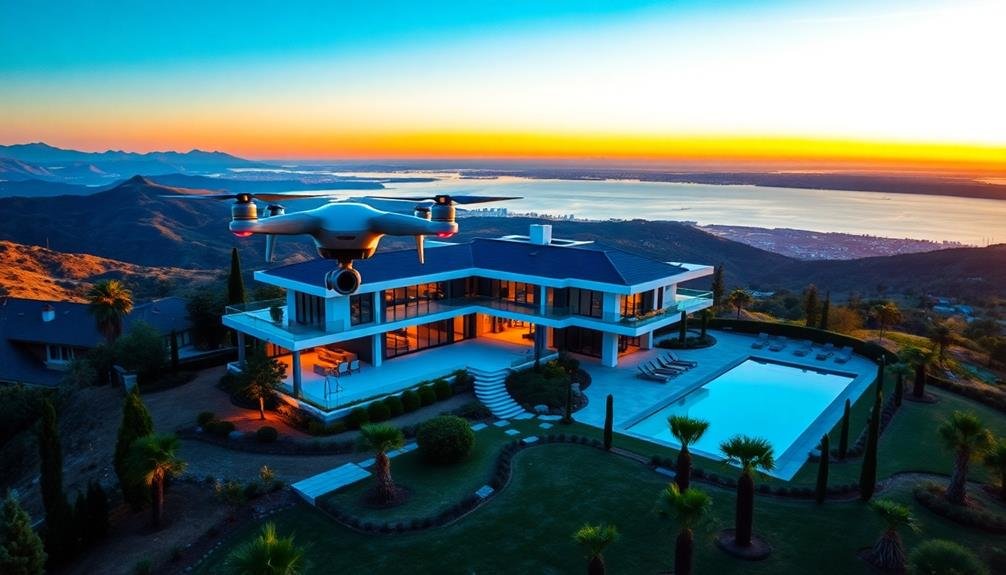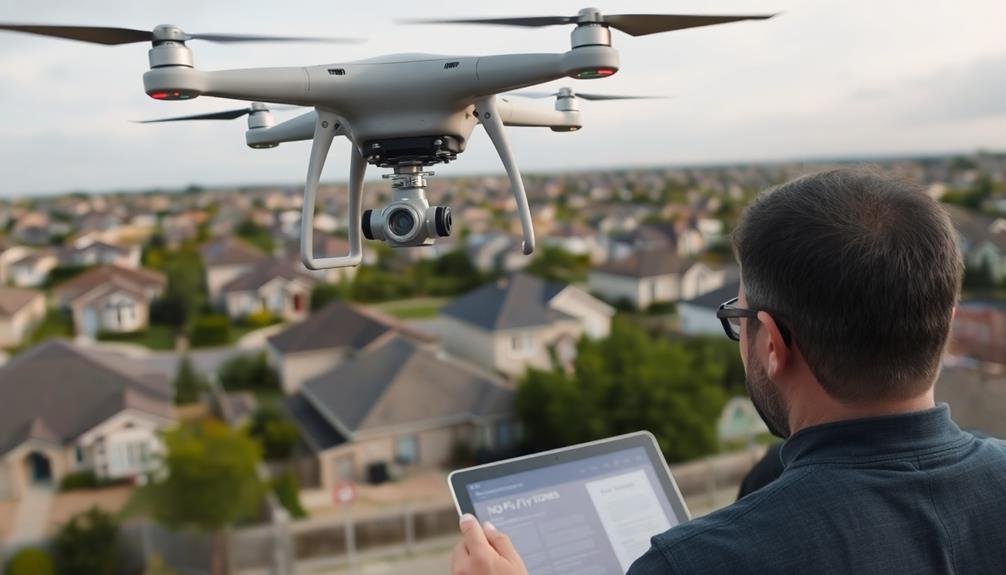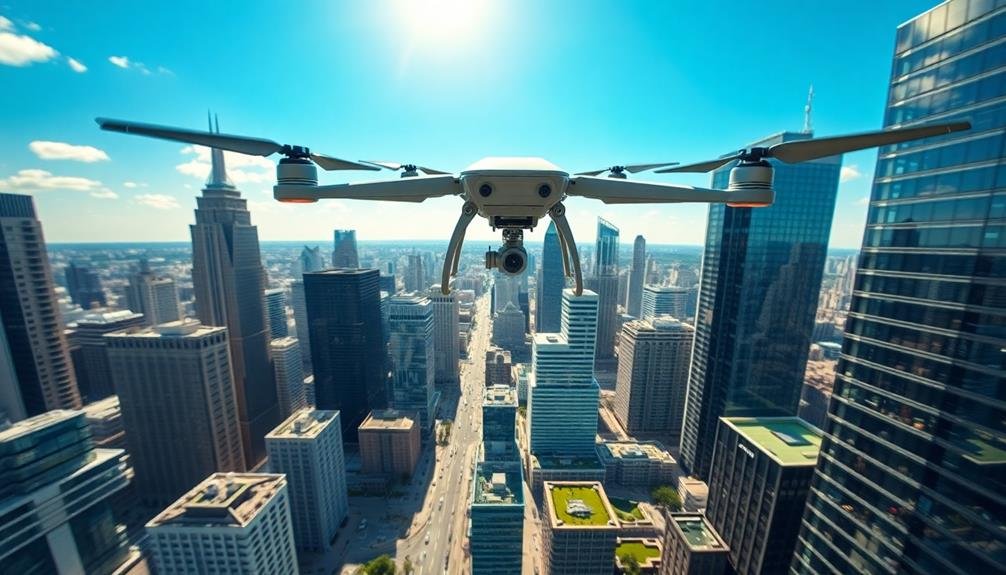Sky-high video tours are innovative marketing tools in real estate that showcase properties from elevated viewpoints using drones or aerial filming equipment. They provide thorough property overviews with panoramic shots, bird's-eye views, and dynamic fly-through sequences. You'll benefit from increased property exposure, enhanced visual storytelling, and the ability to highlight unique features not visible from ground level. These tours create memorable experiences for potential buyers, extending reach beyond local boundaries and differentiating listings from competitors. To create these tours, you'll need specialized equipment like drones, 360-degree cameras, and high-resolution video recorders. Discover how this cutting-edge technology is transforming the way properties are marketed and viewed.
Key Takeaways
- Sky-High Video Tours are innovative real estate marketing tools using drones or aerial equipment to showcase properties from elevated viewpoints.
- They provide comprehensive property overviews with panoramic shots, bird's-eye views, and dynamic fly-through sequences.
- These tours offer potential buyers a complete virtual experience, highlighting unique features and surrounding areas not visible from ground level.
- They revolutionize visual storytelling in real estate by creating immersive narratives that guide buyers through properties and foster emotional connections.
- Sky-High Video Tours extend property exposure beyond local boundaries, attracting a wider audience and increasing the likelihood of listings going viral.
Defining Sky-High Video Tours

Sky-high video tours are increasingly becoming a game-changer in the real estate industry. These innovative marketing tools offer potential buyers a unique perspective of properties by showcasing them from an elevated viewpoint. Typically captured using drones or other aerial filming equipment, sky-high video tours provide a thorough overview of a property's exterior, surrounding landscape, and neighborhood.
You'll find that these tours go beyond traditional ground-level photography or videos. They allow you to see the property's layout, its proximity to nearby amenities, and the overall character of the area. Sky-high video tours often include sweeping panoramic shots, bird's-eye views of the property, and dynamic fly-through sequences that give you a sense of actually approaching and exploring the location.
These tours aren't just limited to the exterior. Many incorporate seamless shifts from outdoor aerial footage to interior walkthroughs, creating a complete virtual experience.
Benefits for Real Estate Marketing

Sky-high video tours offer remarkable benefits for your real estate marketing efforts.
You'll considerably increase your property's exposure, reaching a wider audience through alluring aerial footage that stands out in listings.
These tours also enhance your visual storytelling capabilities, allowing you to showcase the property's full scope, surrounding area, and unique features in a compelling and immersive way.
Increased Property Exposure
One of the most notable benefits of sky-high video tours in real estate marketing is the dramatically increased property exposure. These aerial tours allow you to showcase properties in ways that were previously impossible, reaching a wider audience and generating more interest from potential buyers.
By incorporating sky-high video tours into your marketing strategy, you'll:
- Extend your reach beyond local boundaries, attracting out-of-town or international buyers who can't visit in person.
- Highlight unique features and surrounding areas that aren't visible from ground-level photos or traditional videos.
- Create a memorable and immersive experience that sets your listings apart from competitors.
You'll find that these tours can remarkably boost your property's online visibility. They're highly shareable on social media platforms, increasing the likelihood of your listing going viral.
Additionally, search engines often prioritize video content, meaning your property is more likely to appear in relevant search results.
Sky-high video tours also allow you to showcase the property's location and surrounding amenities more effectively. You can capture nearby parks, schools, shopping centers, and other points of interest that might appeal to potential buyers, giving them a thorough view of the neighborhood and lifestyle they'd be investing in.
Enhanced Visual Storytelling
Every real estate property has a unique story to tell, and sky-high video tours have revolutionized the art of visual storytelling in the industry. These aerial videos allow you to showcase a property's best features from angles that were previously impossible to capture. You can highlight the expansive grounds of a luxury estate, the proximity to local amenities, or the breathtaking views from a high-rise apartment.
With sky-high video tours, you're not just showing a house; you're painting a picture of a lifestyle. You can create a narrative that guides potential buyers through the property, from the grand entrance to the backyard oasis. These tours help buyers envision themselves living in the space, creating an emotional connection that's vital in decision-making.
Moreover, you can use drone footage to provide context about the neighborhood and surrounding areas. This gives buyers a thorough understanding of the property's location and its relation to nearby attractions.
Equipment Used for Aerial Tours

You'll need specialized equipment to capture stunning aerial footage for real estate tours.
Drones and UAVs are essential for capturing sweeping views and unique angles of properties.
To enhance your aerial tours, consider incorporating 360-degree cameras and high-resolution video recorders, which will provide immersive experiences and crystal-clear visuals for potential buyers.
Drones and UAVs
In addition to traditional photography and videography equipment, drones and Unmanned Aerial Vehicles (UAVs) have revolutionized the real estate industry's approach to aerial tours. These compact, remote-controlled devices offer unparalleled flexibility and cost-effectiveness for capturing stunning aerial footage of properties and their surroundings.
When you're considering using drones for your real estate aerial tours, keep in mind the following advantages:
- Versatility: Drones can access hard-to-reach areas, providing unique perspectives of properties.
- Cost-efficiency: They're more affordable than hiring helicopters or planes for aerial shots.
- High-quality imagery: Modern drones offer 4K video and high-resolution photo capabilities.
You'll need to guarantee you're complying with local regulations when operating drones for commercial purposes. Typically, you'll need to register your drone with the FAA and obtain a Remote Pilot Certificate.
It's also vital to respect privacy laws and obtain necessary permissions when filming over private property.
As drone technology continues to advance, you can expect even more sophisticated features, such as longer flight times, improved stabilization, and enhanced obstacle avoidance systems, making aerial tours an increasingly essential tool in real estate marketing.
360-Degree Cameras
Along with drones, 360-degree cameras have become essential tools for creating immersive aerial tours in real estate. These cameras capture a complete spherical view of a property, allowing potential buyers to explore every angle as if they were there in person.
You'll find various types of 360-degree cameras on the market, ranging from consumer-grade models to professional setups. When selecting a camera for real estate purposes, consider factors like image quality, ease of use, and compatibility with virtual tour software.
Here's a comparison of popular 360-degree cameras used in real estate:
| Camera Model | Resolution | Field of View | Live Streaming | Price Range |
|---|---|---|---|---|
| Ricoh Theta Z1 | 23MP | 360° | Yes | $$$$ |
| Insta360 ONE X2 | 18MP | 360° | Yes | $$ |
| GoPro MAX | 16.6MP | 360° | Yes | $$$ |
| Matterport Pro2 | 134MP | 360° | No | $$$$$ |
| Kandao QooCam 8K | 30MP | 360° | Yes | $$$ |
To create a truly immersive experience, you'll need to combine 360-degree ground-level footage with aerial shots from drones. This combination provides a thorough view of the property, both inside and out, giving potential buyers a thorough understanding of the space before they even step foot on the premises.
High-Resolution Video Recorders
High-resolution video recorders form the backbone of aerial real estate tours. These devices capture stunning footage of properties, allowing potential buyers to experience virtual walkthroughs from unique angles.
You'll find that modern recorders offer 4K or even 8K resolution, ensuring crisp, detailed images that showcase every aspect of a property.
When selecting a high-resolution video recorder for aerial tours, consider these key features:
- Image stabilization
- Wide dynamic range
- Low-light performance
These capabilities help you capture smooth, well-balanced footage in various lighting conditions.
You'll want a recorder that's lightweight yet durable, as it'll be mounted on a drone or other aerial platform. Many models now come with built-in GPS for geotagging, which can be useful for mapping out property boundaries.
Look for recorders with high frame rates, typically 60fps or higher, to capture fluid motion during flyovers. Some advanced models offer features like slow-motion recording and time-lapse capabilities, adding creative options to your aerial tours.
Regulations and Legal Considerations

Maneuvering the legal landscape, real estate professionals using drone technology for sky-high video tours must be aware of various regulations and legal considerations.
You'll need to comply with Federal Aviation Administration (FAA) rules, which require commercial drone operators to obtain a Remote Pilot Certificate. This involves passing an aeronautical knowledge test and registering your drone.
You must adhere to airspace restrictions, avoiding no-fly zones near airports, military bases, and other sensitive areas. Flying below 400 feet and maintaining visual line of sight with your drone are vital FAA requirements.
Additionally, you'll need to respect privacy laws and obtain permission before filming private property or individuals.
Insurance is another significant consideration. You should have liability coverage to protect yourself from potential accidents or property damage. Some states may have additional regulations, so it's important to research local laws.
Lastly, make sure you're following real estate marketing regulations. Accuracy in representation is vital, and you must avoid misleading potential buyers with drone footage that misrepresents the property or its surroundings.
Best Practices for Capturing Footage

Drone pilots capturing sky-high video tours for real estate must master several best practices to guarantee stunning footage. You'll need to plan your flight path meticulously, considering the property's best angles and features.
It's significant to choose the right time of day for ideal lighting, often during the "golden hours" just after sunrise or before sunset. You should also be mindful of weather conditions, avoiding windy days that can cause shaky footage.
When filming, maintain a steady and slow flight speed to create smooth, professional-looking videos. Use gentle movements and gradual shifts between shots. Don't forget to capture a mix of wide establishing shots and closer views of key property features.
Here are three essential tips for high-quality drone footage:
- Use manual camera settings for consistent exposure throughout the flight
- Shoot in 4K resolution to allow for cropping and post-production flexibility
- Employ ND filters to control shutter speed and achieve cinematic motion blur
Remember to respect privacy by avoiding shots that intrude on neighboring properties.
Always prioritize safety, keeping the drone in sight and away from obstacles. With practice and attention to detail, you'll create compelling sky-high video tours that showcase properties at their best.
Editing and Post-Production Techniques

Once you've captured your stunning aerial footage, it's time to transform it into a polished, professional video tour. Start by organizing your clips and selecting the best shots that showcase the property's key features.
Use video editing software to trim and arrange these clips into a cohesive sequence. Add smooth shifts between scenes to create a seamless flow. Incorporate slow motion for dramatic effect on particularly impressive shots.
Adjust color grading and exposure to guarantee consistency throughout the video. Consider adding text overlays to highlight important information about the property.
Choose appropriate background music that enhances the mood without overpowering the visuals. Confirm the audio levels are balanced and complement the footage.
If you're including voiceover narration, record it in a quiet environment and mix it carefully with the music.
Integrating Tours Into Listings

The crown jewel of your real estate marketing efforts is now ready to shine. It's time to integrate your sky-high video tour into your property listings. This step is essential for maximizing the impact of your aerial footage and attracting potential buyers.
Start by uploading your edited video to a hosting platform like YouTube or Vimeo. Confirm the video's privacy settings allow for public viewing. Next, embed the video directly into your property listing on your website and popular real estate platforms. Make sure it's prominently displayed, ideally near the top of the page, to catch viewers' attention immediately.
To fully leverage your sky-high video tour, consider:
- Creating a dedicated landing page for the property, featuring the video as the centerpiece
- Sharing snippets or teasers of the video on social media platforms to drive traffic to your listing
- Including a QR code linked to the video in your print marketing materials
Don't forget to optimize your video's title, description, and tags for search engines. This will help potential buyers find your listing more easily when searching for properties in the area.
Future of Aerial Real Estate Videos

Innovations in aerial real estate videos are rapidly transforming the industry. You'll soon see drones equipped with advanced cameras capable of capturing 8K resolution footage, providing ultra-high-definition views of properties.
These drones will also feature improved stabilization technology, ensuring smoother and more professional-looking videos.
Artificial intelligence will play a significant role in the future of aerial real estate videos. AI-powered software will automatically edit footage, select the best shots, and create polished presentations without human intervention.
You'll also see the integration of augmented reality, allowing potential buyers to interact with the aerial footage and access additional information about the property and surroundings.
As regulations evolve, you can expect to see more night-time aerial videos, showcasing properties in a different light.
Thermal imaging cameras may become standard, offering insights into a property's energy efficiency.
Additionally, live-streaming capabilities will enable real-time virtual tours, allowing agents to interact with remote buyers during the flight.
These advancements will make aerial real estate videos an even more powerful tool for marketing properties and engaging potential buyers.
Frequently Asked Questions
How Much Do Sky-High Video Tours Typically Cost?
You'll typically spend between $500 to $2,000 for a sky-high video tour. Costs vary based on property size, location, and video quality. Some high-end properties might require more expensive packages, potentially exceeding $5,000 for premium services.
Can Sky-High Tours Be Done for Interior Spaces?
Yes, you can get sky-high tours for interior spaces. They're not limited to exteriors. You'll see impressive aerial views of rooms, hallways, and open floor plans. It's a great way to showcase large or unique indoor areas.
What Weather Conditions Are Ideal for Capturing Aerial Footage?
You'll want clear, calm days for the best aerial footage. Low wind speeds are essential for stable shots. Early morning or late afternoon light can create stunning visuals. Avoid rain, fog, or harsh midday sun.
How Long Does It Take to Produce a Sky-High Video Tour?
You'll typically need 1-3 days to produce a sky-high video tour. This includes planning, filming, and editing. It's a quick turnaround, but you'll want to guarantee perfect weather conditions for the best footage.
Are There Any Privacy Concerns With Sky-High Video Tours?
You should be aware of privacy concerns with sky-high video tours. They can capture neighboring properties, potentially invading privacy. Always obtain necessary permissions and consider obscuring sensitive areas to protect others' privacy rights.
In Summary
You've now gained insight into sky-high video tours in real estate. They're a powerful marketing tool that can set your listings apart. Remember to follow regulations, invest in quality equipment, and hone your filming and editing skills. As technology advances, these aerial tours will likely become even more immersive and interactive. By embracing this trend, you'll stay ahead of the curve and provide potential buyers with compelling, bird's-eye views of properties.

As educators and advocates for responsible drone use, we’re committed to sharing our knowledge and expertise with aspiring aerial photographers.




Leave a Reply